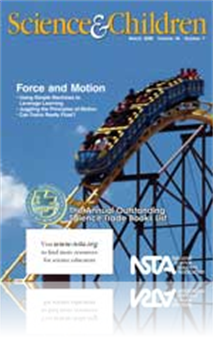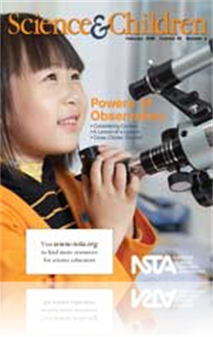All Science and Children resources
Journal Article
Simple Machines in the Community
The community can be a powerful context and mini-laboratory for cultivating students’ common understandings of science and mathematics. On the island of Panay in the Philippines, the community was the starting place for a group of fifth- and sixth-...
Journal Article
Perspectives: Assessing and Addressing Student Science Ideas
Our students are not blank slates. They come to school with a wide range of experiences that have shaped their science understandings—reading books, watching TV, and playing video games. From many years of research about student science ideas, it i...
Journal Article
We all hope our classrooms don’t take on a circus-like atmosphere, but juggling can be an engaging way to introduce elementary physics to students. The very act of tossing and catching objects can help students to understand the basic physical prin...
Journal Article
The Early Years: Objects in Motion
Objects in motion attract children. The following activity helps children explore the motion of bodies riding in a vehicle and safely demonstrates the answer to their questions, “Why do I need a seatbelt?” Children will enjoy moving the cup aroun...
Journal Article
Science 101: Do balances and scales determine an object’s mass or its weight?
The typical elementary school explanation of the difference between mass and weight goes something like the following: Mass is the amount of matter contained in an object. If you travel to the Moon, another planet, or anywhere far away from Earth, yo...
Journal Article
Libros de Ciencias en Español (2008)
From well-designed series with colorful illustrations and easy-to-read Spanish texts for the very young, to exquisite publishers’ series with eye-catching, close-up photos about the world of animals, to clear explanations about basic concepts of en...
Journal Article
Perspectives: Learning to Observe <em>and</em> Infer
Researchers describe the need for students to have multiple opportunities and social interaction to learn about the differences between observation and inference and their role in developing scientific explanations (Harlen 2001; Simpson 2000). Helpin...
Journal Article
Science 101: How does a telescope work?
It turns out that telescopes, microscopes, and binoculars all work on the same principles, so you get three for one in this answer. They give us information that we can’t get with the unaided eye. To do that, these devices gather as much informatio...
Journal Article
A Walk in the “Tall, Tall Grass”
This inquiry-based lesson was inspired by Denise Fleming’s book entitled, In the Tall, Tall Grass (1991). The author used the book and a real study of prairie grasses to teach kindergartners how to make careful observations and record what they see...
Journal Article
In this science investigation based on the 5E learning model, students moved through four different centers designed to focus their attention on the concepts of mass, volume, and density. At these stations, students encountered discrepant events that...
Journal Article
Children’s descriptions of commonplace objects and events of life are often limited because they do not provide adequate information about the context of their observation. Encouraging primary and early intermediate students to consider the context...
Journal Article
Editor’s Note: Teaching Observation—Aim Higher
Observation is a fundamental process in science. It is a skill that many science curricula emphasize. It seems like such a simple skill, but observation skills are not quite so simply mastered. Like anything else, just watching and observing does lit...
Journal Article
Science Shorts: Observation Versus Inference
When you observe something, how do you know for sure what you are seeing, feeling, smelling, or hearing? Asking students to think critically about their encounters with the natural world will help to strengthen their understanding and application of ...




